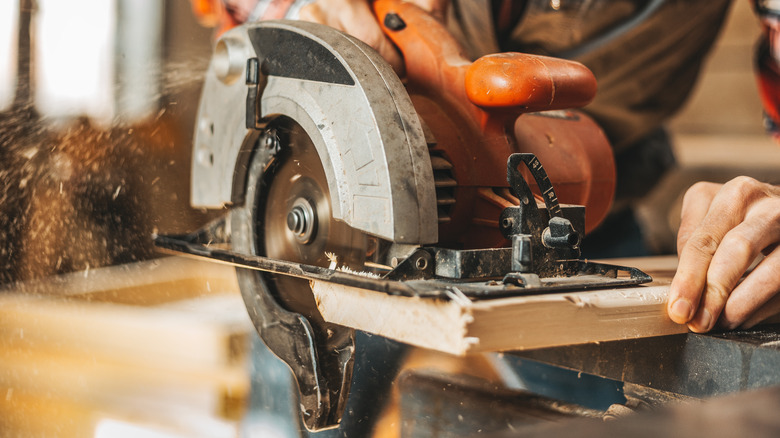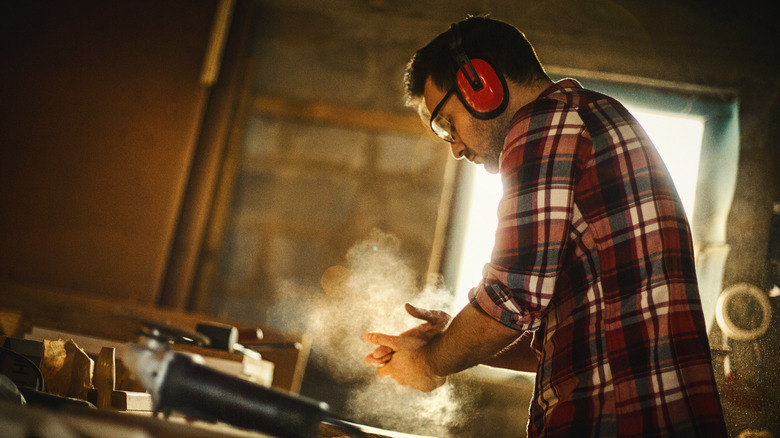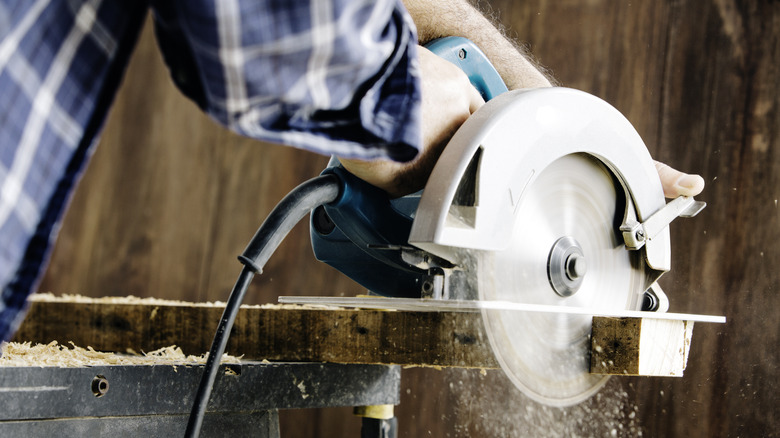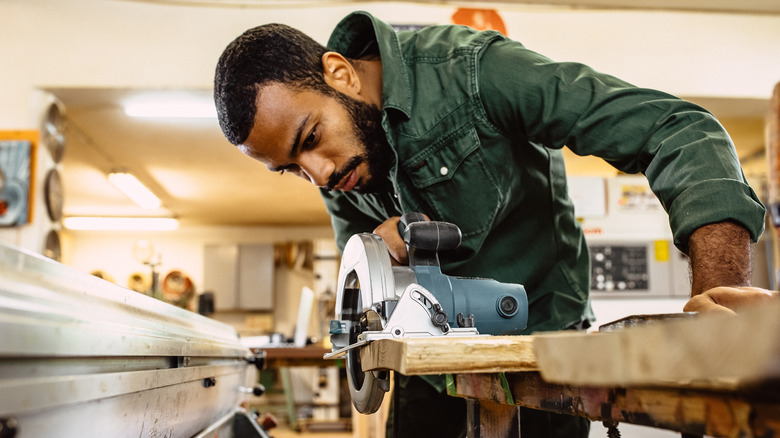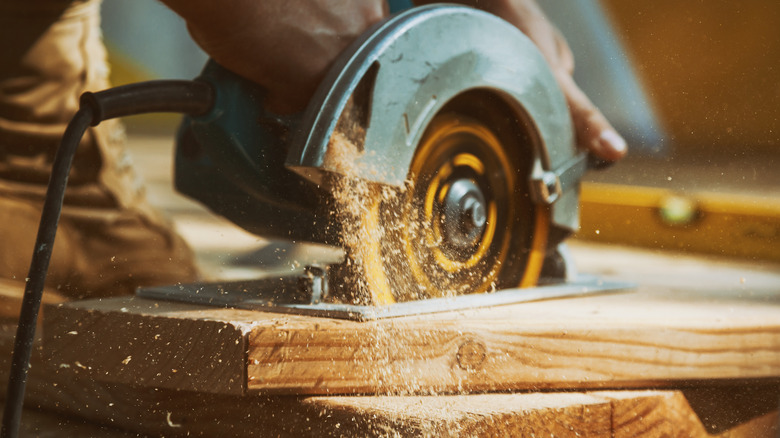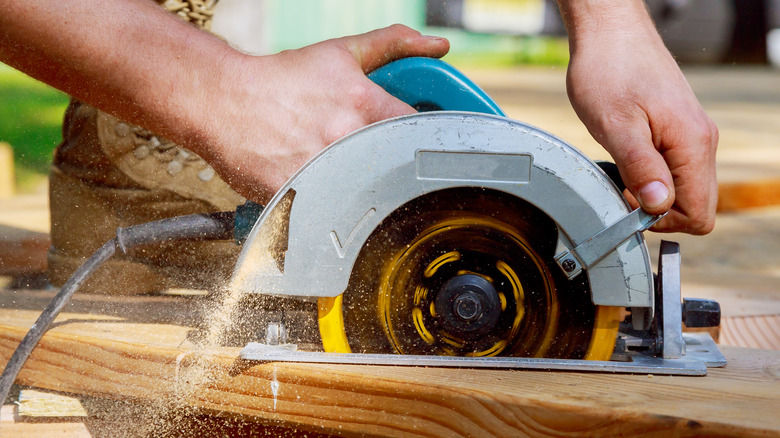5 Helpful Tips For Circular Saw Safety
A circular saw is just about the most versatile tool when it comes to making straight cuts. It might take a bit of preparation to achieve the kind of accuracy you'd expect from a table saw or a chop saw, but the circular saw's hand-held portability makes it useful in a variety of situations where other saws just wouldn't be effective. Circular saws are also very easy to use, making them an ideal tool for weekend home repairs. This is why many consider them to be a must-have tool for every home garage. However, any spinning blade can be dangerous if you don't take the proper precautions before using it.
Most of you already know that keeping your hands well away from the saw blade is important if you want to keep all your fingers. It's also common knowledge that a good, sharp saw blade from a top brand will help ensure a cleaner cut than a dull one. But there are several other safety measures that should be taken to prevent accidents when using this tool. Here are five tips to help you use your circular saw safely.
Wear protective gear
There are three main kinds of protective gear that can help ensure your safety when using a circular saw: eye protection, ear protection, and a dust mask. You should always wear safety glasses any time you operate any kind of electric saw, because they protect your eyes from dust and small pieces of flying debris that might shoot off the saw and fly at your face. It's also important that you use a pair of actual safety glasses designed for impact resistance. There are several ratings associated with protective eyewear, but the two to keep in mind are the Z87.1 rating, which means the glasses have been successfully tested for impact resistance, and the D5 rating, which means they've been approved for adequate protection against fine dust.
Ear protection is also important. Circular saws are loud, and prolonged exposure to the noise can damage your hearing. You can use foam earplugs or over-ear mufflers, whichever you prefer. Anything that can reduce the roar of the saw to a dull murmur is effective.
Finally, there are dust masks. Many carpenters may be able to get by just fine with a paper mask for small projects that only require a few cuts, but those who will be spending long hours in the swirling dust of the saw should make sure they have a respirator that can adequately filter out the fine dust particles. Breathing in too much sawdust can result in sinus pain, infections, headaches, and even breathing issues.
Avoid loose clothing and jewlery
This one might seem obvious, but you would be amazed at how many accidents occur from people wearing loose clothing or jewelry near spinning blades. This is dangerous because the fabric, cords, or metal from these garments and accessories can get caught in the spinning teeth of the saw and pull you in.
Loose sleeves, watches, and bracelets tend to be the most precarious since they are close to your hands, which are the parts of you closest to the blade. Scarves, necklaces, and neckties are hazardous as well since you usually need to lean your body over the saw as you cut. However, it can happen with parts of your clothes that you might not expect. An unzipped jacket that lays flat when you stand upright might drape dangerously when you're leaning over a project. Untied shoelaces can also be a source of concern if you are standing or kneeling on the surface you're cutting. But one of the worst offenders is drawstrings. Many hoodies and jackets have them, and it's all too easy to forget they're there until you're leaning over a project and notice them dangling dangerously close to your saw.
One of the best and simplest ways to prevent this is to take off any jewelry you don't need, and then lean forward to make sure none of your clothes drape unexpectedly.
Never force the saw
It is always best practice when using the circular saw to line up the cut, keep the shoe firmly against the surface, and then let the saw reach full speed before slowly introducing it to the material you're cutting. You should never have to push the saw too hard when moving at the correct pace. It should easily slide forward as the teeth of the blade remove the material in front of it.
There will be times when you encounter resistance, though. This can be caused by several things. You could hit a hard knot in the material you're cutting. Your saw blade may have become dull and need to be sharpened or replaced. The material might be inadequately supported and pinching the sides of the blade as it sags. You could have simply overtightened the saw blade and need to loosen it a bit so that it can spin freely. Whatever the source of the resistance, you might find the saw suddenly not wanting to move forward.
Do not, under any circumstances, try to force the saw forward. This can make the saw's teeth catch, which can cause the saw to jump. This is bad under any circumstances as it can ruin the cleanliness of your cut, but it can also cause serious injury.
Only cut on a clean and stable surface
You might not need every cut to be surgical in its precision, but you should still ensure that every piece you are cutting is perfectly clean and stable before introducing it to a circular saw. The workspace should be free from loose tools, nails, and any other kind of debris that could potentially roll or vibrate into the saw's path. This will ensure that nothing unexpected gets caught by the saw that could either cause it to jump or create a projectile launched by the spinning blade.
Each piece you're cutting should be level, stable, and supported in at least two places on each side. There are many instances of cuts going wrong when people try to cut a large sheet of plywood or lumber by balancing it across a single pair of sawhorses. This causes the wood to lean in or out as it starts to become two separate pieces, and the wood can then pinch the sides of the saw blade. You need at least four sawhorses to ensure that both sides are adequately supported during the cut. An alternative method is to lay down a sheet or two of pink insulation foam on the ground and then cut the wood on top of it. This ensures that the entire piece is fully supported and that it won't bow or pinch anywhere.
Wait for the saw to stop before lifting it
So, you've made all your preparations, lined up your saw, and made a clean, safe cut. Good work! Now, the last thing to keep in mind is that you should never remove your circular saw from a cut until the blade has completely stopped. You might be tempted to immediately remove the saw once you've finished the cut, but the blade will continue to spin for several seconds after you release the trigger. This means that the saw is still "active," even though it isn't receiving any more power.
Prematurely removing an active saw can cause one of the still-spinning teeth to hit the edge of the cut, making the saw jump. Even if it's removed from the cut without incident, it's still not particularly safe to hold or set down a circular saw that is actively spinning. Some circular saws have retractable guards that help prevent the blade from damaging anything when it isn't making a cut. This is good to have, but it's still considered best practice to leave the saw in place until the blade is completely stationary.
